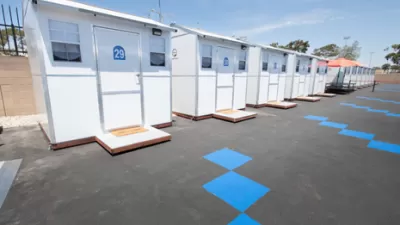Cities are incentivizing more affordable housing types and limiting permits for short-term rentals in an effort to keep housing affordable for residents.

The modular housing industry continues to grow as the housing crisis forces creative solutions that combine safety and comfort with cost-effectiveness.
In an article for Reasons to be Cheerful, Corey Buhay writes that the idea isn’t entirely new. “In the 1970s, the federal government dumped millions of dollars in subsidies into modular home factories across the US. But the subsidies couldn’t change the fact that the technology wasn’t good enough to make or move the homes efficiently.” Prefabricated homes also faced the stigma attached to ‘mobile homes’ and low-income residents.
Today, prefabricated homes can fit neatly into neighborhoods. In Colorado, locally produced prefab homes are starting to fill a growing housing gap. The Colorado manufacturer, Fading West, says it can produce a home at a cost 20 percent less than traditional housing. “The city of Boulder, Colorado, is in the middle of building a 31,375-square-foot modular housing factory that will produce manufactured homes for local residents starting in late 2024. Aurora, Colorado, also passed a resolution earlier this year to increase its use of modular housing.”
Other ways Colorado cities are addressing the housing crisis include limiting short-term rentals, controlling water rights based on affordable housing production, and creating community land trusts and affordable housing subsidies.
FULL STORY: Are Sleek Modular Homes the Future of Affordable Housing?

Alabama: Trump Terminates Settlements for Black Communities Harmed By Raw Sewage
Trump deemed the landmark civil rights agreement “illegal DEI and environmental justice policy.”

Planetizen Federal Action Tracker
A weekly monitor of how Trump’s orders and actions are impacting planners and planning in America.

The 120 Year Old Tiny Home Villages That Sheltered San Francisco’s Earthquake Refugees
More than a century ago, San Francisco mobilized to house thousands of residents displaced by the 1906 earthquake. Could their strategy offer a model for the present?

In Both Crashes and Crime, Public Transportation is Far Safer than Driving
Contrary to popular assumptions, public transportation has far lower crash and crime rates than automobile travel. For safer communities, improve and encourage transit travel.

Report: Zoning Reforms Should Complement Nashville’s Ambitious Transit Plan
Without reform, restrictive zoning codes will limit the impact of the city’s planned transit expansion and could exclude some of the residents who depend on transit the most.

Judge Orders Release of Frozen IRA, IIJA Funding
The decision is a victory for environmental groups who charged that freezing funds for critical infrastructure and disaster response programs caused “real and irreparable harm” to communities.
Urban Design for Planners 1: Software Tools
This six-course series explores essential urban design concepts using open source software and equips planners with the tools they need to participate fully in the urban design process.
Planning for Universal Design
Learn the tools for implementing Universal Design in planning regulations.
Clanton & Associates, Inc.
Jessamine County Fiscal Court
Institute for Housing and Urban Development Studies (IHS)
City of Grandview
Harvard GSD Executive Education
Toledo-Lucas County Plan Commissions
Salt Lake City
NYU Wagner Graduate School of Public Service





























